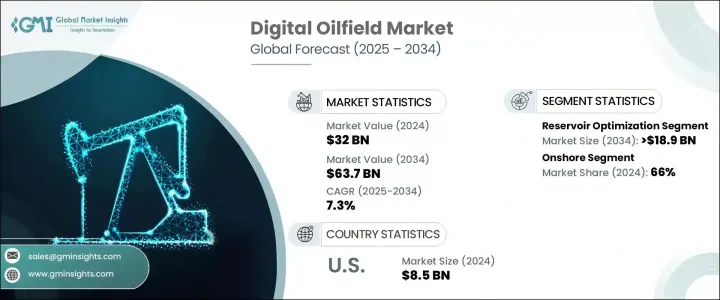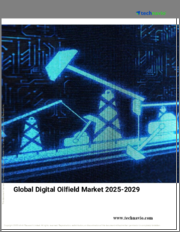
|
시장보고서
상품코드
1766305
세계의 디지털 유전 시장 : 기회, 성장 촉진요인, 산업 동향 분석, 예측(2025-2034년)Digital Oilfield Market Opportunity, Growth Drivers, Industry Trend Analysis, and Forecast 2025 - 2034 |
||||||
세계의 디지털 유전 시장은 2024년 320억 달러로 평가되었으며 CAGR 7.3%로 성장해 2034년까지 637억 달러에 이를 것으로 추정됩니다.
이 성장은 석유 및 가스의 업스트림 및 중류 부문에서 작업의 합리화, 의사결정의 신속화, 안전 프로토콜의 강화가 추진되게 된 것이 주된 요인입니다.

실시간 분석과 원격 액세스가 운영의 중심이 되어 기업은 집중 관리 시스템을 활용하여 가동 시간과 자산 이용률을 향상시키고 있습니다. 엄청나게 높아지는 규제 압력에 직면하는 가운데 업계의 디지털 시프트는 계속 견인력을 가지고 있습니다.
| 시장 범위 | |
|---|---|
| 시작 연도 | 2024년 |
| 예측 연도 | 2025-2034년 |
| 시작 금액 | 320억 달러 |
| 예측 금액 | 637억 달러 |
| CAGR | 7.3% |
유층 최적화는 유전 운영자가 인공지능과 머신러닝에 기여하여 고정밀 모델링과 자원 배분을 실현하기 때문에 2034년까지 189억 달러에 이를 것으로 예측됩니다. 분석을 자동화하고 생산 비용을 줄이면서 회수 전략을 강화합니다. 운영 효율성을 희생시키지 않으면서 유층 생산량을 극대화하는 데 중점을 둡니다.
2024년 점유율은 육상 배치가 66%를 차지했고 2034년까지 CAGR 7%로 예측됩니다. 모니터링 및 분석 도구의 향상으로 환경 성능과 운영 성과가 향상되고 있습니다.
미국의 디지털 유전 2024년 시장 규모는 85억 달러로, 2034년까지 170억 달러에 이를 것으로 추정됩니다.
디지털 유전 시장에서 활약하는 주요 기업으로는 General Electric, Digi International, Siemens, Rockwell Automation, Kuwait Oil Company, Honeywell International, EDG, Intel Corporation, National Oilwell Varco, Saudi Arabian Oil Company(Saudi Aramco), Cisco Systems, Accenture, ABB, Enovate Upstream, Info Systems, Schneider Electric, Halliburton, WEG, CGG, Sinopec Oilfield Service Corporation, SLB, Weatherford, Katalyst Data Management, Aviat Networks, Wipro 등이 있습니다. 대기업은 예측 분석을 개선하고 예기치 않은 다운타임을 줄이기 위해 AI와 머신러닝에 많은 투자를 하고 있습니다. 기업은 또한 데이터와 인프라를 보호하기 위해 사이버 보안 업그레이드를 선호합니다.
목차
제1장 조사 방법과 범위
제2장 주요 요약
제3장 업계 인사이트
- 생태계 분석
- 규제 상황
- 업계에 미치는 영향요인
- 성장 촉진요인
- 업계의 잠재적 위험 및 과제
- 성장 가능성 분석
- Porter's Five Forces 분석
- PESTEL 분석
제4장 경쟁 구도
- 소개
- 기업의 시장 점유율 분석
- 전략적 노력
- 경쟁 벤치마킹
- 혁신과 기술의 상황
제5장 시장 규모와 예측 : 공정별, 2021-2034년
- 주요 동향
- 생산 최적화
- 저류층 최적화
- 드릴링 최적화
- 기타
제6장 시장 규모와 예측 : 서비스별, 2021-2034년
- 주요 동향
- 계기 및 자동화
- 보안 시스템
- 스마트 웰
- 무선 시스템
- 분산제어시스템
- SCADA
- 정보기술
- 소프트웨어
- 컴퓨터 기기 및 용도 하드웨어
- IT 아웃소싱 서비스
- 기타
제7장 시장 규모와 예측 : 용도별, 2021-2034년
- 주요 동향
- 온쇼어
- 오프쇼어
제8장 시장 규모와 예측 : 기술별, 2021-2034년
- 주요 동향
- IoT
- 고급 분석
- 로봇 공학
- 클라우드 컴퓨팅
- 이동성
- 기타
제9장 시장 규모와 예측 : 지역별, 2021-2034년
- 주요 동향
- 북미
- 미국
- 캐나다
- 멕시코
- 유럽
- 러시아
- 노르웨이
- 영국
- 덴마크
- 이탈리아
- 독일
- 네덜란드
- 프랑스
- 아시아태평양
- 중국
- 인도
- 인도네시아
- 말레이시아
- 태국
- 호주
- 중동 및 아프리카
- 사우디아라비아
- 이라크
- 쿠웨이트
- 아랍에미리트(UAE)
- 카타르
- 오만
- 나이지리아
- 남아프리카
- 라틴아메리카
- 브라질
- 아르헨티나
제10장 기업 프로파일
- ABB
- Accenture
- Aviat Networks
- CGG
- Cisco Systems
- Digi International
- EDG
- Emerson Electric
- Enovate Upstream
- General Electric
- Halliburton
- Honeywell International
- Infosys Limited
- Intel Corporation
- Katalyst Data Management
- Kuwait Oil Company
- National Oilwell Varco
- OleumTech.
- Pason Systems
- Rockwell Automation
- Saudi Arabian Oil Company(Saudi Aramco)
- Schneider Electric
- Siemens
- Sinopec Oilfield Service Corporation
- SLB
- Weatherford
- WEG
- Wipro
The Global Digital Oilfield Market was valued at USD 32 billion in 2024 and is estimated to grow at a CAGR of 7.3% to reach USD 63.7 billion by 2034. This growth is largely driven by the increasing push for streamlined operations, faster decision-making, and heightened safety protocols across upstream and midstream oil and gas sectors. The ongoing shift to smart technologies-such as artificial intelligence, the Internet of Things (IoT), and cloud platforms-is transforming traditional practices into automated, predictive, and data-rich systems.

With real-time analytics and remote access becoming central to operations, companies are harnessing centralized control systems to improve uptime and asset utilization. Enhanced productivity, operational agility, and cost optimization remain key benefits fueling this transformation. In the face of fluctuating oil prices, aging equipment, climate concerns, and mounting regulatory pressures, the industry's digital shift continues to gain traction. However, the widespread implementation of digital oilfield solutions still encounters resistance due to steep initial investments, cybersecurity vulnerabilities, and legacy cultures that are slow to embrace innovation.
| Market Scope | |
|---|---|
| Start Year | 2024 |
| Forecast Year | 2025-2034 |
| Start Value | $32 billion |
| Forecast Value | $63.7 billion |
| CAGR | 7.3% |
Reservoir optimization is projected to reach USD 18.9 billion by 2034, as oilfield operators lean into artificial intelligence and machine learning to deliver high-precision modeling and resource allocation. Real-time data is leveraged to automate performance analytics and enhance recovery strategies while reducing production costs. The emphasis on maximizing reservoir output without sacrificing operational efficiency is expected to keep this segment at the forefront of the market.
Onshore deployment accounted for a 66% share in 2024 and is forecasted to grow at a CAGR of 7% through 2034. Onshore sites benefit from greater access to existing infrastructure, more manageable costs, and fewer regulatory complications, which accelerates the uptake of digital platforms. Enhanced monitoring and analytics tools are improving environmental performance and operational output. Offshore sites, despite being more remote and exposed to tougher conditions, are gradually adopting digitalization to simplify operations and increase reliability.
United States Digital Oilfield Market was valued at USD 8.5 billion in 2024 and is estimated to reach USD 17 billion by 2034, driven by a strong drive to modernize aging infrastructures and adopt cost-saving innovations. With regulatory support and increased capital directed toward digital transformation, companies in the US are prioritizing efficiency and sustainability. The nation's mature oil and gas ecosystem continues to embrace digital tools that reduce downtime and improve system responsiveness.
Key companies active in the Digital Oilfield Market include General Electric, Digi International, Siemens, Rockwell Automation, Kuwait Oil Company, Honeywell International, EDG, Intel Corporation, National Oilwell Varco, Saudi Arabian Oil Company (Saudi Aramco), Cisco Systems, Accenture, ABB, Enovate Upstream, Infosys Limited, Emerson Electric, OleumTech, Pason Systems, Schneider Electric, Halliburton, WEG, CGG, Sinopec Oilfield Service Corporation, SLB, Weatherford, Katalyst Data Management, Aviat Networks, and Wipro. Leading players are heavily investing in AI and machine learning to improve predictive analytics and reduce unplanned downtime. Strategic collaborations with tech firms allow for seamless integration of IoT, cloud, and SCADA systems across field operations. Companies are also prioritizing cybersecurity upgrades to safeguard data and infrastructure. Mergers and acquisitions are being used to expand digital portfolios and gain competitive advantage.
Table of Contents
Chapter 1 Methodology & Scope
- 1.1 Market definitions
- 1.2 Base estimates & calculations
- 1.3 Forecast calculation
- 1.4 Data sources
- 1.4.1 Primary
- 1.4.2 Secondary
- 1.4.2.1 Paid
- 1.4.2.2 Public
Chapter 2 Executive Summary
- 2.1 Industry synopsis, 2021 - 2034
Chapter 3 Industry Insights
- 3.1 Industry ecosystem analysis
- 3.2 Regulatory landscape
- 3.3 Industry impact forces
- 3.3.1 Growth drivers
- 3.3.2 Industry pitfalls & challenges
- 3.4 Growth potential analysis
- 3.5 Porter's analysis
- 3.5.1 Bargaining power of suppliers
- 3.5.2 Bargaining power of buyers
- 3.5.3 Threat of new entrants
- 3.5.4 Threat of substitutes
- 3.6 PESTEL analysis
Chapter 4 Competitive landscape, 2025
- 4.1 Introduction
- 4.2 Company market share analysis, 2024
- 4.3 Strategic initiatives
- 4.4 Competitive benchmarking
- 4.5 Innovation & technology landscape
Chapter 5 Market Size and Forecast, By Process, 2021 - 2034 (USD Million)
- 5.1 Key trends
- 5.2 Production optimization
- 5.3 Reservoir optimization
- 5.4 Drilling optimization
- 5.5 Others
Chapter 6 Market Size and Forecast, By Service, 2021 - 2034 (USD Million)
- 6.1 Key trends
- 6.2 Instrumentation & automation
- 6.2.1 Security systems
- 6.2.2 Smart wells
- 6.2.3 Wireless systems
- 6.2.4 Distributed control system
- 6.2.5 SCADA
- 6.3 Information technology
- 6.3.1 Software
- 6.3.2 Computer equipment & application hardware
- 6.3.3 IT outsourcing services
- 6.3.4 Others
Chapter 7 Market Size and Forecast, By Application, 2021 - 2034 (USD Million)
- 7.1 Key trends
- 7.2 Onshore
- 7.3 Offshore
Chapter 8 Market Size and Forecast, By Technology, 2021 - 2034 (USD Million)
- 8.1 Key trends
- 8.2 IoT
- 8.3 Advance analytics
- 8.4 Robotics
- 8.5 Cloud computing
- 8.6 Mobility
- 8.7 Others
Chapter 9 Market Size and Forecast, By Region, 2021 - 2034 (USD Million)
- 9.1 Key trends
- 9.2 North America
- 9.2.1 U.S.
- 9.2.2 Canada
- 9.2.3 Mexico
- 9.3 Europe
- 9.3.1 Russia
- 9.3.2 Norway
- 9.3.3 UK
- 9.3.4 Denmark
- 9.3.5 Italy
- 9.3.6 Germany
- 9.3.7 Netherlands
- 9.3.8 France
- 9.4 Asia Pacific
- 9.4.1 China
- 9.4.2 India
- 9.4.3 Indonesia
- 9.4.4 Malaysia
- 9.4.5 Thailand
- 9.4.6 Australia
- 9.5 Middle East & Africa
- 9.5.1 Saudi Arabia
- 9.5.2 Iraq
- 9.5.3 Kuwait
- 9.5.4 UAE
- 9.5.5 Qatar
- 9.5.6 Oman
- 9.5.7 Nigeria
- 9.5.8 South Africa
- 9.6 Latin America
- 9.6.1 Brazil
- 9.6.2 Argentina
Chapter 10 Company Profiles
- 10.1 ABB
- 10.2 Accenture
- 10.3 Aviat Networks
- 10.4 CGG
- 10.5 Cisco Systems
- 10.6 Digi International
- 10.7 EDG
- 10.8 Emerson Electric
- 10.9 Enovate Upstream
- 10.10 General Electric
- 10.11 Halliburton
- 10.12 Honeywell International
- 10.13 Infosys Limited
- 10.14 Intel Corporation
- 10.15 Katalyst Data Management
- 10.16 Kuwait Oil Company
- 10.17 National Oilwell Varco
- 10.18 OleumTech.
- 10.19 Pason Systems
- 10.20 Rockwell Automation
- 10.21 Saudi Arabian Oil Company (Saudi Aramco)
- 10.22 Schneider Electric
- 10.23 Siemens
- 10.24 Sinopec Oilfield Service Corporation
- 10.25 SLB
- 10.26 Weatherford
- 10.27 WEG
- 10.28 Wipro




















